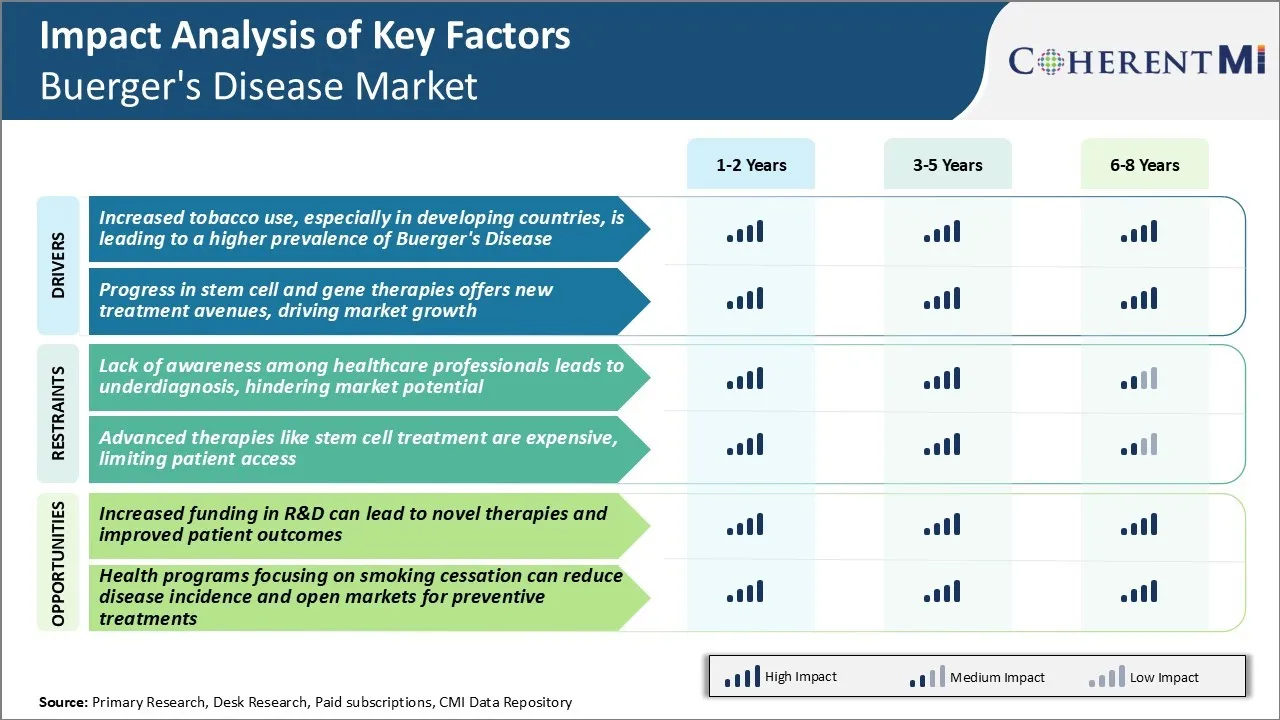Buerger's Disease Market ANÁLISE DE TAMANHO E PARTICIPAÇÃO - TENDÊNCIAS DE CRESCIMENTO E PREVISÕES (2024 - 2031)
Buergers Disease Market is segmented By Treatment (Medications (Vasodilators, Anticoagulants, Calcium Channel Blockers, Antiplatelet Agents) Surgical Interventions (Sympathectomy, Amputation) , Advanced Therapies (Stem Cell Therapy, Gene Therapy, Hyperbaric Oxygen Therapy)), By Route of Administration (Oral, Injectable, Topical), By End User (Hospitals, Clinics, Specialty Centers, Research Institutes), By Distribution Channel (Hospital Pharmacies, Retail Pharmacies, Online Pharmacies), By Geography (North America, Latin America, Asia Pacific, Europe, Middle East, and Africa). The report offers the value (in USD million) for the above-mentioned.
Buerger's Disease Market Trends
Market Driver - Increased Tobacco Use and Buerger's Disease Prevalence
Buerger's disease, also known as thromboangiitis obliterans, is a progressive inflammatory condition that causes the blood vessels of the limbs to narrow and become blocked. Experts believe long-term tobacco use, particularly smoking, acts as a primary trigger for the pathogenesis of the disease. Theexact mechanism is still unclear, however, it is thought that chemicals in tobacco compromise the immune system andpromote blood clots in the smaller and medium-sized arteries as well as veins of the limbs.
Areas where tobacco remains deeply entrenched in local culture have witnessed growing Burger's disease prevalence in recent times. Rural India is a prime example, where smoking rates have soared while regulatory measures have lagged behind urban progress. The rising availability and social acceptability of these products has contributed to higher rates of tobacco addiction among young adults and teenagers.
Hospital admission trends reflect this disturbing pattern, with more young farmers and laborers seeking treatment for the late stages of the disease each year. Countries in Southeast Asia and parts of Africa also face a looming threat as tobacco multinationals aggressively market their products. Without urgent public health interventions, Buerger's disease is projected to place a huge strain on these developing healthcare infrastructures.
Market Driver - Progress in Stem Cell and Gene Therapies
Scientific advances have opened new horizons for more effective Burger's disease treatment in recent years. Researchers are making promising headway in developing novel cellular and genetic therapies. For instance, stem cell therapies involve harvesting bone marrow or muscle tissue stem cells and reintroducing them intravenously to encourage re-growth of healthy endothelial cells lining the inside of blood vessels.
A parallel area of focus involves gene therapies where selected genes are either overexpressed or silenced to modulate the immunological and thrombotic processes implicated in Buerger's disease. Viral vectors are being engineered to deliver corrective genetic payloads specifically to inflamed vessel walls. Some early experiments on animal models have demonstrated success in restoring blood flow by this approach. Companies are further strengthening these vectors and optimizing delivery methods for subsequent human trials.
Other innovative therapies on the horizon include treatments based on modified RNA interference, monoclonal antibodies and immune checkpoint inhibitors. With advances in delivery technologies, it may also become possible to administer these advanced therapies locally for improved outcomes. Growing clinical research activity and sizable private sector investments in this domain are indicative of its promising commercial potential going forward.

Market Challenge - Lack of Awareness Among Healthcare Professionals
One of the key challenges faced in the Buerger's disease market is the lack of adequate awareness about the condition among healthcare professionals. Buerger's disease, also known as thromboangiitis obliterans, is a relatively rare non-inflammatory vascular condition that affects small and medium-sized blood vessels in the arms and legs.
However, many primary care physicians and general practitioners still have low levels of knowledge about the signs, symptoms, and mechanisms of this disease. This leads to underdiagnosis of the condition in its early stages. By the time patients are correctly diagnosed, their disease has often reached an advanced phase with greater complexity in treatment.
The low diagnosis rates also mean that the true prevalence and burden of Buerger's disease in the general population is unclear. With improved medical education and dissemination of clinical guidelines, more cases can be picked up early thereby helping patients access effective treatment options in a timely manner. This will potentially expand the market opportunity over the long term.
Market Opportunity - Increased Funding in R&D Can Lead to Novel Therapies and Improved Patient Outcomes
Significant funding and support for research into Buerger's disease can unlock new opportunities to drive better health outcomes and market expansion. Currently, treatment landscapes are still evolving as the pathophysiology of the condition remains not fully understood. Increased investments into well-designed clinical trials and laboratory-based investigations can help validate new drug targets and develop advanced treatment modalities.
For example, stem cell therapy is a promising area that needs more research to evaluate its clinical utility for regenerating damaged blood vessels in Buerger's disease patients. Novel drug delivery systems may also help optimize delivery of existing pharmaceuticals to targeted tissues.
With a rising focus on personalized medicine, companion diagnostics could play a role in predicting individual responses. Overall, ramping up R&D activities can accelerate the entry of novel, effective and well-tolerated therapies. This, in turn, addresses current unmet needs and therefore opens the possibility of capturing more market share over time.